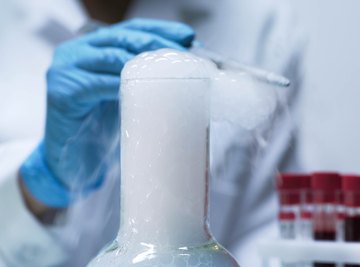
The halogens include, fluorine, chlorine, bromine, iodine and astatine. At room temperature, the lighter halogens are gases, bromine is a liquid and the heavier halogens are solids, reflecting the range of boiling points found in the group. The boiling point of fluorine is -188 degrees Celsius (-306 degrees Fahrenheit), while iodine’s boiling point is 184 degrees Celsius (363 degrees Fahrenheit), a difference that, like atomic radius, is associated with higher atomic mass.
TL;DR (Too Long; Didn't Read)
Heavier halogens have more electrons in their valence shells. This can make Van der Waals forces stronger, slightly increasing boiling point.
The Halogens
The halogens are members of what is called Group 17 on the periodic table, which are named because they represent the seventeenth column from the left. The halogens all exist as diatomic molecules in nature. In other words, they exist as two joined atoms of the element. Halogens react with metals to form halides and are oxidizing agents, especially fluorine, which is the most electronegative element. Lighter halogens are more electronegative, lighter in color, and have lower melting and boiling points than heavier halogens.
Van der Waals Dispersion Forces
The forces that hold the molecules of halogens together are called Van der Waals dispersion forces. These are the forces of intermolecular attraction that must be overcome for liquid halogens to reach their boiling points. Electrons move in a random fashion around the nucleus of an atom. At any one time, there may be more electrons on one side of a molecule, creating a temporary negative charge on that side and a temporary positive charge on the other side -- an instantaneous dipole. The temporary negative and positive poles of different molecules attract each other, and the sum of the temporary forces results in a weak intermolecular force.
Atomic Radii and Atomic Mass
Atomic radii tend to get smaller as you move from left to right along the periodic table and larger as you move down the periodic table. Halogens are all part of the same group. However, as you move down the periodic table, the halogens with larger atomic numbers are heavier, have a larger atomic radii, and have more protons, neutrons and electrons. Atomic radius does not influence boiling point, but both are influenced by the number of electrons associated with the heavier halogens.
The Effect on Boiling Point
The heavier halogens have more electrons in their valance shells, making more opportunities for the temporary imbalances that create Van der Waals forces. With more opportunities to create instantaneous dipoles, the dipoles occur more frequently, making the Van der Waals forces stronger between the molecules of heavier halogens. It takes more heat to overcome these stronger forces, meaning that the boiling points are higher for heavier halogens. Van der Waals dispersion forces are the weakest intermolecular forces, so the boiling points of the halogens as a group are generally low.
References
About the Author
Based in Wenatchee, Wash., Andrea Becker specializes in biology, ecology and environmental sciences. She has written peer-reviewed articles in the "Journal of Wildlife Management," policy documents,and educational materials. She holds a Master of Science in wildlife management from Iowa State University. She was once charged by a grizzly bear while on the job.
